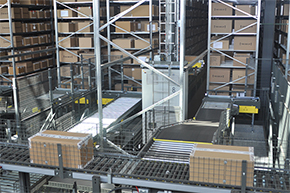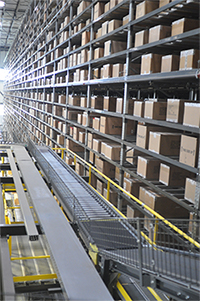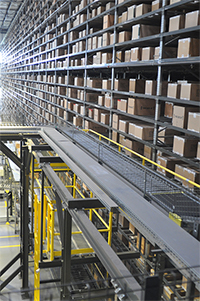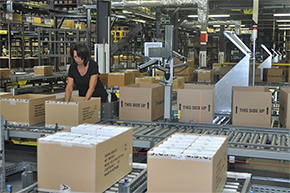Planning a new DC in a narrow footprint
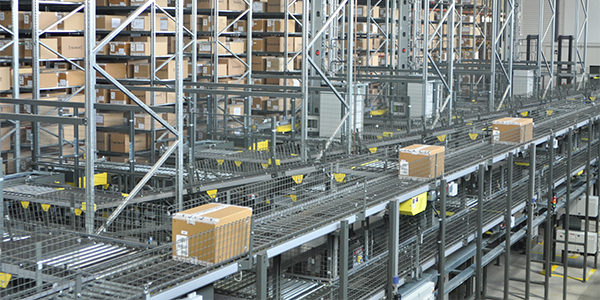
As the venerable footwear retailer Clarks can attest, shoes are not the easiest products to distribute. For one thing, each style comes in a wide range of sizes, widths, and colors. For another, shoes and boots are often bulky. So it helps to have sophisticated software and handling systems to help navigate the complexities. That's exactly what Clarks Americas now has at its new DC in Hanover, Pa.
British-based Clarks was founded in England in 1825 when brothers Cyrus and James Clark made their first pair of sheepskin slippers. Today, it has grown into a global corporation that includes the Bostonian and Hanover brands.
It was the Hanover Shoe acquisition in the late 1970s that first brought Clarks to the small Pennsylvania town of the same name, where the company already had a factory and distribution center. Shoe production has since moved overseas, but distribution for all of Clarks in the Americas remains in Hanover today, albeit with some modifications. The company has seen steady growth since that acquisition—growth that eventually would lead to capacity limitations that would take more than just polish to address.
"We were outgrowing the walls there," recalls Ed Smith, project manager and facilities engineer. "We knew we could not get by for long. Plus, we needed to invest in new technologies to replace the old technologies we had that were simply worn out."
HANOVER HOLDOVERClarks did not want to abandon Hanover for a location closer to interstate highways. It had a long history there, as well as an experienced and dependable work force. Hanover is also a short drive from the Port of Baltimore, through which most of its imports arrive. As it happened, Clarks found sufficient land to build directly across the street from the former DC.
Planning for the new facility began more than a decade ago, but the Great Recession put the project on hold. In many ways, the delay was fortuitous, as a notable portion of the company's business has since shifted to the direct-to-consumer channel. When work on the facility resumed, Clarks changed gears and designed a building that can handle multichannel distribution from a shared inventory pool. Today, this includes distribution to more than 300 Clarks-branded stores, a wholesale channel, and e-commerce orders.
Another benefit of starting over was that it gave the company the opportunity to "reverse engineer" the design process. That is, it allowed the Clarks team to determine what technologies would best support the flow of goods and then design a facility around them. After evaluating a number of material handling solutions, the Clarks managers decided to go with automated systems from Knapp.
FEET FEATThe facility, which went live in May 2014, serves all of North and South America. It boasts Knapp's OSR Shuttle goods-to-person picking system and a large automated storage and retrieval system (AS/RS) that stores more than half a million cases of shoes. Knapp handled the design and integration, supplied the conveyors and sortation systems, and installed the warehouse management system (WMS) that directs all of the activities. The three-shift operation has the capacity to distribute more than 25 million pairs of shoes annually.
The project was not without its challenges, however. For one thing, the available land was limited, so Clarks decided to build upward instead of outward, making extensive use of automated equipment. For another, because the DC was built close to town, building codes restricted the facility's height. Although a variance was granted to build to a height of 70 feet above ground level, space would still be tight. So to fit in the AS/RS, a four-level facility was constructed with the bottom level underground when viewed from the front entrance.
The new building has a relatively modest footprint of about 450,000 square feet, with some additional footage to expand when needed. The automated systems use the full height of the facility, while picking is performed on mezzanine levels, which have additional mezzanines located above them to accommodate future growth.
"We wanted to make sure we had the capacity to meet our future business needs," says Paul Clark, Clarks' group performance and optimization leader. "We can grow that capacity in places by adding more picking stations and other work areas. So it gives us some flexibility."
The automated systems occupy most of the facility. Approximately two-thirds of the building consists of racking, including racks for automated storage. The DC also contains conventional racks, which are used to hold some packed products and which are serviced by Raymond forklifts.
SHOE ARRIVALSToday, products flow through the automated facility with choreographed precision. Processing begins at the facility's four receiving docks, where ocean containers filled with goods are unloaded. Most of the merchandise arrives floor-stacked in the containers, which enter the country through the ports of Baltimore, New York, and Philadelphia. Two Caljan telescopic conveyors from Rite-Hite extend into the containers to aid in the unloading process, with each conveyor able to move between two of the four doors.
Incoming cases are first weighed and measured. About 3 percent are then conveyed to a vendor compliance area, where these receipts are further inspected for quality. Some repack may also be done in this area if vendor cartons don't meet the minimum standards for automated processing.
Label applicators next place a bar code "license plate" onto each received carton, including those that have passed through the compliance area. The cartons are then scanned using fixed scanners from industrial sensor manufacturer Sick and conveyed to a large carton-level AS/RS. The system has 14 aisles and 30 levels of racking. TGW storage and retrieval cranes operate in the aisles, which are 600 feet long. The cranes are equipped to carry two cartons at a time to 511,000 locations, where they are stored double deep.
To build goodwill with the Hanover community, Clarks provides tours to local school groups and even allowed students to name the storage and retrieval machines. For instance, one machine is named BOB, short for "bring our boxes." The students also drew pictures of their namesakes that are displayed on the fencing at the ends of the aisles.
RUNNING SHOESAs orders arrive, the warehouse management system directs the AS/RS to retrieve needed items. These are conveyed to the large active OSR Shuttle system for fulfillment.
"The OSR is the bread and butter of our operation," says Smith. "Knapp uses algorithms to put the inventory in the right place, and then we rely on the solution to do the work."
The OSR Shuttle features 10 aisles and multiple levels of storage positions. Robotic shuttles glide on rails on each level to service the positions. The OSR is actually two systems in one, with each functioning separately. OSR1 is used to feed order picking stations, while OSR2 holds packed goods until they are ready for shipping.
The company experiences two peak seasons—December/January and July/August. In an effort to balance work load during these peaks, orders like those for the wholesale channel are filled in advance and placed into OSR2, where they're held for shipment. "This allows us to get ahead from an order fulfillment perspective," says Paul Clark. "We can smooth out the workflow, and it [frees up] capacity for when we need to make a big push."
The OSR system has 235 total shuttles, with about four shuttles operating on most levels within each aisle. Upon arrival from the AS/RS, products are diverted to an aisle, raised vertically by lifts to the assigned level, and then transferred onto the shuttles for horizontal transport to the storage positions. When an order is prepped for assembly, the shuttles retrieve the items for delivery to 10 goods-to-person processing stations. Five stations are located on the ground floor, with the other five on a mezzanine level above. Each of the 10 aisles is dedicated to one of the picking stations to shorten delivery time, but the system is designed to deliver products from any aisle to any station.
Only one order is processed at a time at a station, and only one stock-keeping unit (SKU) of source product is presented. This makes it virtually impossible to pick the wrong product.
The picking process begins with an order carton that's been automatically erected. The cartons come in a variety of sizes, with most holding either six or 12 shoeboxes. There are also cartons designed for one, two, or three pairs, which are useful for e-commerce orders. The order carton is given a bar-code label, which is scanned to marry that carton to the order.
The first SKU needed for the order is then delivered to the station. A display shows how many pairs of that SKU to pick from the source carton, which holds the shoes in individual shoeboxes. The worker selects a shoebox and scans it with a Datalogic scanner to confirm the pick before placing the box into an order carton. If additional pairs of that SKU are needed for the order, the worker will repeat the process as often as necessary.
The source carton is then returned to the OSR, and the system presents the next carton containing items for the order. This continues until either the order carton is full, in which case another order carton is presented, or the order is complete. The average order line consists of 1.3 items.
The order cartons next head to packing. The packing area contains 28 stations, about eight of which are used for value-added services like special labeling, although the design provides for any station to be used for these services if needed. Smaller cartons are packed manually—workers add air-cushion dunnage from FP International, close the cartons, and apply shipping labels before placing them on takeaway conveyors.
Larger cartons, such as the six- and 12-pair cartons, are sent through two automated closing machines. The machines measure the contents of the cartons, cut their tops down to just above the topmost shoebox, apply a lid, and seal it onto the top of the carton. Right-sizing the shipment provides for better cubing of trailers and saves on freight costs. A shipping label is automatically printed and applied using equipment from Weber Packaging Solutions. The weight and volume of each carton are also captured using Mettler Toledo systems.
Cartons that are not yet ready to ship are conveyed either to OSR2 for temporary holding or to the conventional rack areas. Cartons that are ready for loading onto a truck are conveyed to an inline sorter with roller diverts that send cartons to 13 dispatch lanes based on carrier and route.
ROOM TO GROWAs for how the new DC is working out, the Clarks managers say they are pleased with the results. Among other benefits, the dense storage provided by the automated systems has enabled the company to shoehorn more product into what is a relatively small footprint. The new facility also allows for higher throughput with less labor and fewer touches than were required in the old building. On top of that, the setup gives Clarks room to grow along with the ability to flex with changing markets.
"The world is changing around us, so we have to react to that," notes Paul Clark. "We'll continue to work with Knapp to stretch the capabilities of our systems even further."
A version of this article appears in our December 2017 print edition under the title "There's no business like shoe business."
Related Articles

Copyright ©2024. All Rights ReservedDesign, CMS, Hosting & Web Development :: ePublishing
